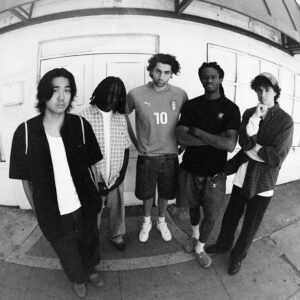In a single frame—searing, static, and violently still—No. 18, the bio-engineered warrior known for her composure and poise, is caught in a moment that shatters all illusion of invincibility. Her back arcs against a splintered wall, fragments of destruction flying outward like glass blades suspended mid-air. Her mouth is open in a scream—not just of pain, but of defiance, of the body’s refusal to fold silently. Blood spills from her lips, a thin stream rendered with crimson starkness, staining her chin and breaking the stoic mask that fans have come to expect from the ice-cold combatant.
This is not just a fight scene. This is the narrative freeze-frame where vulnerability becomes part of the myth. It is pain writ large across steel and flesh, a visual manifesto of defeat and resilience.
Clothing as Context: Armor by Another Name
Her outfit, while seemingly casual, functions as a visual metaphor for rebellion and reconstruction. The black short-sleeve shirt worn over a long-sleeved, horizontally striped undershirt speaks to a duality: external toughness wrapped over a more complex, emotionally nuanced core. The denim trousers with bold golden belt buckle ground her not in tactical combat gear but in stylized Americana, a subversion of standard sci-fi attire—elegant, almost civilian.
But now, these garments are wrinkled, torn in motion, bunched around her waist and hips in a way that betrays violent trajectory and failed resistance. The clothes are no longer just identifiers—they are evidence. A forensic echo of impact. We see not just who she is, but what has been done to her.
Facial Expression and Physiological Detail: Anatomy of Agony
The anguish etched across 18’s face is both anatomical and symbolic. Her jaw is stretched open in a howl that feels less like surrender and more like survival. It is the kind of involuntary cry that emerges when willpower is no longer enough to silence the scream.
Her right eye squints shut with pain while the left remains half-lidded, revealing the moment’s sensory overload. A singular teardrop of blood trickles from the edge of her mouth—a visual punctuation that underscores just how personal this encounter has become. This is not a sanitized battle for the screen; this is a war between flesh and impress, code and catastrophe.
The Wall and Its Language: Canvas of Collision
The surface behind her is not just a wall—it is a visual register of trauma. Cracks radiate outward from the point of contact like frozen lightning bolts. The cyan-blue hue is surreal, almost synthetic, giving the illusion of an interdimensional battle space rather than an earthly structure. But the effect is chillingly real. The wall, like her body, is fractured but standing.
The wall acts as both resistance and witness—it reflects the violence of the encounter, preserving the evidence of power unleashed. The physicality of the space becomes a language of force. Every shard of flying matter, every dented plate, every ripple of distortion is a footnote in the tale of impact.
The Aesthetic of Falling: Dynamic Composition and Freeze-Frame Brutality
What elevates this moment into the realm of high anime storytelling is its composition. The way her body is curved mid-air, knees bent upward, hands frozen in mid-flinch—it captures not just pain, but the choreography of destruction. It’s the brutal ballet of being outmatched, the physics of failure.
The frame does not center on her triumph. It doesn’t flatter her. It documents her. There is no protective lighting, no heroic angle—just an unflinching lens held up to the aftermath of force. It is gorgeous in its cruelty, like classical tragedy illustrated through hypermodern brushwork.
Biomechanics and Battle Context: The Failure of Synthetic Precision
No. 18 is not human. She is an android—created by Dr. Gero for the express purpose of obliteration without remorse. Her endurance is hardwired, her strength pre-programmed. And yet, here, we see the falter of that machinery. Not in sparks or shattered cybernetics, but in the very human way her body absorbs damage.
The presence of blood—something she should not technically produce—is not a continuity error, but a symbolic narrative flourish. It reminds us that while 18 may be synthetic, her experience of harm is no less real. This is the failure of the invulnerable. This is what it means to bleed despite being built not to.
This moment suggests her attacker is not simply powerful but catastrophic—likely Bio-Broly, the monstrous, mutating clone of a warrior whose rage knows no shape, only destruction. To be slammed by such a being is not a loss. It is a confrontation with existential erasure.
Gender, Power, and the Portrayal of Female Pain
In many anime universes, female characters are often exempt from this kind of brutal realism. They might fall, but rarely do they suffer. Here, that convention is obliterated with unflinching force. Android 18’s pain is not stylized into eroticism or dulled into melodrama. It is graphic, immediate, and devastating.
And yet, even in this state, there is no sense of surrender. Her body may be collapsing, but her expression—screaming, desperate, furious—speaks of someone who still hasn’t given up. She may lose this battle. But she is not destroyed. That, perhaps, is the true core of power.
The Viewer’s Role: Bearing Witness, Feeling Helpless
The image, particularly in fan communities by 18vsbiobrolymania, resonates not just because of its brutality but because it asks viewers to contend with their complicity. You are not just watching a fight—you are seeing someone you admire, even idolize, being overpowered.
This forces a confrontation between power fantasy and emotional vulnerability. It challenges fans to reconsider what it means to root for strength. Do you celebrate only victories? Or do you respect the moment when your hero is hurt but still refuses to break?
Momemtum
What happens after this moment matters. Will 18 rise again, covered in dust and defiance? Will she pivot, rebuild, evolve? Or will she be sidelined, like so many female characters whose arcs peak with specified impressions.
The promise of such a powerful moment lies in what follows. Because falling is only tragic when it leads to silence. When it becomes foundation, it becomes mythology. Android 18 has always been more than her programming—this scene proves it once again.
Flow
This is not just a still frame of Android 18 being hurled into a wall. It is a portrait of friction between design and destiny, a study in what happens when strength meets something uncontainable. It is as much about what breaks as it is about what doesn’t.
In her pain, we see resistance. In her scream, we hear defiance. And in the blood—impossible, crimson, too human—we are reminded that even constructs of perfection can suffer. But more importantly, they can return.
Android 18 may be down in this moment, but she is far from out. She remains a mirror of our own paradoxes: machine yet emotional, tough yet breakable, built to fight, but still—somehow—capable of feeling.
No comments yet.








